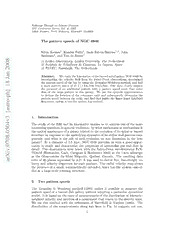Table Of ContentPathways Through an Eclectic Universe
ASP Conference Series, Vol. #, 2007
Johan Knapen, Terry Mahoney, Alexandre Vazdekis
The pattern speeds of NGC 6946
Silvia Toonen1, Kambiz Fathi2, Jesu´s Falc´on-Barroso1,3, John
2 1
Beckman , and Tim de Zeeuw
8
1) Leiden Observatory, Leiden University, The Netherlands
0
0 2) Instituto de Astrof´ısica de Canarias, La Laguna, Spain
2 3) ESTEC, Noordwijk, The Netherlands
n
a Abstract. WestudythekinematicsofthebarredspiralgalaxyNGC6946by
J investigating the velocity field from Hα Fabry-Perot observations, determined
8 the pattern speed of the bar by using the Tremaine-Weinberg method, and find
1
a main pattern speed of 21.7 (+4.0,-0.8) km/s/kpc. Our data clearly suggest
the presence of an additional pattern with a pattern speed more than twice
]
h that of the large pattern in this galaxy. We use the epicycle approximation
p to deduce the location of the resonance radii and subsequently determine the
- pattern speed between the radii, and find that inside the Inner Inner Lindblad
o
Resonance radius, a bar-like system has evolved.
r
t
s
a
[
3 1. Introduction
v
4
The study of the ISM and its kinematics enables us to address one of the more
0
5 interestingquestionsingalactic evolution: bywhatmechanismormechanismsis
0 the optical appearance of a galaxy related to the evolution of its spiral or barred
. structure in response to the underlying dynamics of its stellar and gaseous com-
8
0 ponents, and what is the role of such evolution on star formation in the host
7 galaxy? At a distance of 5.5 Mpc, NGC 6946 provides us with a good oppor-
0 tunity to study and characterize the properties of interstellar gas and dust in
:
v detail. The observations were taken with the Fabry-Perot interferometer FaN-
i TOmM (Hernandez, Gach, Carignan & Boulesteix 2003) at the 1.6-m telescope
X
at the Observatoire du Mont M´egantic, Qu´ebec, Canada. The resulting data
r
a cube of 40 planes separated by 0.21 ˚A was used to derive flux, line-of-sight ve-
locity and velocity dispersion for each position. The radial velocity map shows
the presence of a small, asymmetrically extended, inner bar-like system embed-
ded in a large-scale rotating structure.
2. Two pattern speeds
The Tremaine & Weinberg method (1984) makes it possible to measure the
pattern speed of a barred disk galaxy without adopting a particular dynamical
model. It is based on the ratio of measurements of the distribution of intensity-
weighted velocity and position of a component that reacts to the density wave.
We use this method with the refinement of Merrifield & Kuijken (1995). The
distribution of the measurements along two lines in Fig. 1a suggests not one,
1
2 Silvia Toonen
(a) (b)
Figure 1. (a) Pattern speed determination with the Tremaine & Weinberg
method. The pattern speed is given by the ratio of hvi and hxi. Measurements
through the centre are distributed along the line of higher slope, where the
measurements solely through the exterior of the NGC 6946 are accumulated
along the line of lower slope, indicating two distinct pattern speeds. (b) The
(Ω−κ)-curve, with Ω theangular frequency and the κ theepicyclic frequency,
2
indicating two ILRs.
but two distinct pattern speeds for measurements including and excluding the
central regions. This observational result suggests the presence of an additional,
inner pattern that rotates at a different pattern speed roughly inside the OILR.
The outer pattern rotates at 21.7 (+0.5,-0.5) km/s/kpc and the inner pattern
rotates at 47.0 (+1.4,-1.4) km/s/kpc.
3. Resonance radii
We use the epicycle approximation to deduce the location of the Lindblad Reso-
nance radii (ILR) and the Corotation Radius. Fig. 1b shows the (Ω− κ)-curve.
2
ThisindicatestwoILRs;anIILRandOILR.AsdescribedbyMaciejewski(2004),
thecurvecanbeinterpretedasrepresentingagalaxywithoutacentralmasscon-
centration or density cusp. Fig. 1b also indicates that a bar-like system with
solid-body rotation has evolved inside the IILR as confirmed by the steeply ris-
ing rotation curve in this galaxy.
In a forthcoming paper, we will present an extended analysis of the pattern
speeds and a diagnosis of the resonance radii, within the framework of epicycle
approximation, in NGC 6946.
References
Hernandez, O., Gach, J., Carignan, C., & Boulesteix, J. 2003, SPIE, 4841, 1472
Maciejewski, W. 2004, MNRAS, 354, 892
Merrifield, M. R., & Kuijken, K. 1995, MNRAS, 274, 933
Tremaine, S., & Weinberg, M.D. 1984, ApJ, 282, L5

